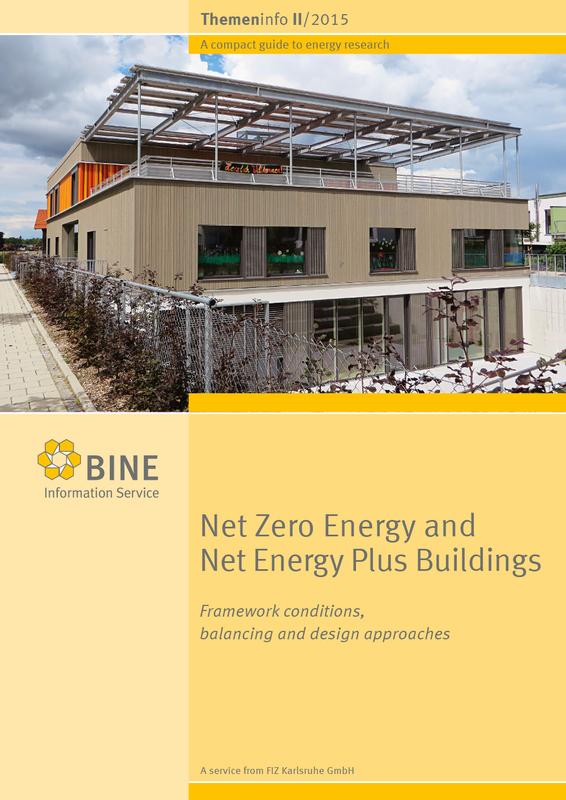Designing buildings with a positive energy balance

The BINE Themen-info brochure “Net Zero Energy and Net Energy Plus Buildings” © BINE Informationsdienst
The BINE Themen-info brochure “Net Zero Energy and Net Energy Plus Buildings” presents the various concepts. One focus is on how the energy balance for these pioneering buildings should be calculated. The spectrum of analysed examples from practice ranges from individual buildings to whole districts.
Uniformly balancing net zero-energy and net energy-plus buildings
In recent years, building concepts with balanced or positive energy and emissions balances have enjoyed increasing popularity among architects and builders. They have names like “energy-plus house”, “zero emissions house”, “efficiency house plus” or “activated-plus house”.
What all these buildings have in common is that, when calculated on average across the year, they do not draw more energy from the grid than they feed into the grid from their own production.
In Germany, however, there is still a lack of uniform standards and definitions for conversion factors, balance limits and for assessing the own requirement.
The embodied energy, i.e. the energy required to produce the building materials and construct the buildings, should also be incorporated in the balance with a view to the entire lifecycle.
Professor Karsten Voss and Eike Musall from the University of Wuppertal are the authors of the BINE-Themeninfo brochure. From 2008 to 2013 they participated in the IEA Working Group “Towards Zero Energy Solar Buildings”. In this Working Group, experts from 18 countries discussed their experiences with such building concepts. The German contribution was made as part of the “EnOB – Research for Energy-Optimised Construction” research initiative initiated by the German Federal Ministry for Economic Affairs and Energy.
You found all informations about the BINE info brochure “Net Zero Energy and Net Energy Plus Buildings” here:
http://www.bine.info/en/press/press-releases/archive-press-releases/pressemittei…
Uwe Milles/Birgit Schneider
presse(at)bine.info
About BINE Information Service
Energy research for practical applications
The BINE Information Service reports on energy research topics, such as new materials, systems and components, as well as innovative concepts and methods. The knowledge gained is incorporated into the implementation of new technologies in practice, because first-rate information provides a basis for pioneering decisions, whether in the planning of energy-optimised buildings, increasing the efficiency of industrial processes, or integrating renewable energy sources into existing systems.
About FIZ Karlsruhe
FIZ Karlsruhe – Leibniz Institute for Information Infrastructure is a not-for-profit organization with the public mission to make sci-tech information from all over the world publicly available and to provide related services in order to support the national and international transfer of knowledge and the promotion of innovation.
Our business areas:
• STN International – the world’s leading online service for research and patent information in science and technology
• KnowEsis – innovative eScience solutions to support the process of research in all its stages, and throughout all scientific disciplines
• Databases and Information Services – Databases and science portals in mathematics, computer science, crystallography, chemistry, and energy technology
FIZ Karlsruhe is a member of the Leibniz Association (WGL) which consists of 87 German research and infrastructure institutions.
http://www.bine.info/en – BINE Informationsdienst
Media Contact
All latest news from the category: Architecture and Construction
Newest articles

A ‘language’ for ML models to predict nanopore properties
A large number of 2D materials like graphene can have nanopores – small holes formed by missing atoms through which foreign substances can pass. The properties of these nanopores dictate many…

Clinically validated, wearable ultrasound patch
… for continuous blood pressure monitoring. A team of researchers at the University of California San Diego has developed a new and improved wearable ultrasound patch for continuous and noninvasive…

A new puzzle piece for string theory research
Dr. Ksenia Fedosova from the Cluster of Excellence Mathematics Münster, along with an international research team, has proven a conjecture in string theory that physicists had proposed regarding certain equations….



